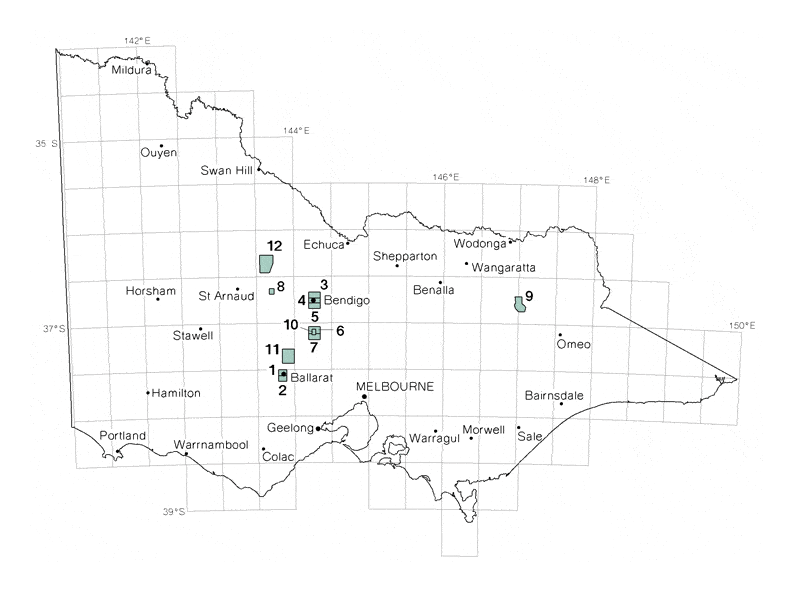History of gold mining in Victoria
Victoria is a world-renowned gold province and our history is closely connected to gold mining.
Gold discovery at Ballarat in 1851 sparked Victoria's famous gold rush. An estimated 6000 diggers (miners) arrived each week seeking their fortune.
Ballarat was considered the world's richest alluvial goldfield during its peak between 1852 and 1853.
Our gold rush brought migrants from all over the world to Victoria. Over the space of one year, nearby Bendigo was transformed from a sheep station into a bustling town of 40,000 people.
Melbourne earned the nickname 'Marvellous Melbourne', drawing comparisons to Paris and London, due to the huge influx of wealth and migrants.
The economic and cultural impact of this mass migration shaped the future of Victoria.

How much gold has Victoria produced?
Victoria has produced over 2400 tonnes of gold which is 32 per cent of all the gold mined in Australia and almost 2 per cent of all the gold ever mined globally.
On a yield per area basis, Victoria has produced an average of 10.8 kilograms of gold per kilometre squared – which is greater than any other Australian state.
These figures stand comparison with any of the present-day mines operating anywhere in Australia.
Over 150 years of gold discovery
Victoria's first officially recognised gold discovery was in 1850 near Clunes, almost 40 kilometres north of Ballarat.
In 1851, the Victorian Government offered a reward of £200 to anyone finding gold within 200 miles (320 kilometres) of Melbourne. Within six months, gold was discovered in Clunes, and then Ballarat, Castlemaine and Bendigo.
The Victorian gold rush would dwarf finds in New South Wales, accounting for more than one third of the world’s gold production in the 1850s.
1854 - Eureka Stockade
On 30 November 1854, miners from Ballarat, disgruntled with the colonial government's management of the goldfields, swore allegiance to the Southern Cross flag at Bakery Hill and built a stockade at the nearby Eureka diggings.
Early on the morning of Sunday 3 December, when the stockade was only lightly guarded, government troops attacked. At least 22 diggers, including one woman, and six soldiers were killed.
Eureka is a significant event in the development of Australia’s representational structures and attitudes towards democracy and egalitarianism.
1869 - Welcome Stranger
The Welcome Strange was the largest gold nugget ever found, is discovered on 5 February by Cornish miners John Deason and Richard Oates near Moliagul in central Victoria.
While searching around the roots of a tree they discovered, 3 cm below the surface, a gold nugget weighing 66kg, worth around $4 million based on today’s gold price.
- 1906 - There was a brief rush to Tarnagulla in central Victoria following the discovery of the Poseidon Nuggets with the largest being 953 oz (27 kilograms).
- 1920s - The Ballarat and Bendigo mines fell silent, and despite brief activity during the Great Depression, the gold mining industry lay dormant until the 1980s. Higher gold prices at that time saw a surge in prospecting and fossicking – largely using electronic detectors - as well as the return of full-scale mining operations to Stawell and Woods Point.
- 1972 - Annual total gold produced in Victoria for a single year dropped to 10kg - lowest level between 1851 and today.
- 1986 - The total annual production of gold in Victoria tops 1,000kg for the first time since 1959.
- 1990s - Gold mining activity in Victoria escalated sharply, with new mines opening and a significant increase in the level of expenditure on exploration. Information available through the Victorian Initiative for Minerals and Petroleum (VIMP) has acted as a catalyst for a rise in the number of applications for exploration licences in surveyed areas.
- 1995 - Construction of an ore processing plant at Costerfield signals the recommencement of mining activities near Heathcote. Productive gold mine continues to operate at site.
- 2005 - Commercial mining begins at Fosterville. The mine is the state’s largest producer today and is on schedule to be in Australia’s top five in 2019.
- 2011 - Underground gold mining and ore processing restarts at Ballarat.
- 2018 - Stawell Gold Mine announces return to production.
Historical images
View historical images of the gold rush era in Victoria:
Historical gold mining documentation
Browse these links for more information about the history of gold mining in Victoria:
Prospecting and fossicking
Looking for gems and minerals, such as gold, can be done using metal detectors or pans. To fossick in Victoria, you need a current fossicking permit known as a miner's right.
Find out about recreational fossicking and buying a miner's right.
Page last updated: 02 Jun 2021